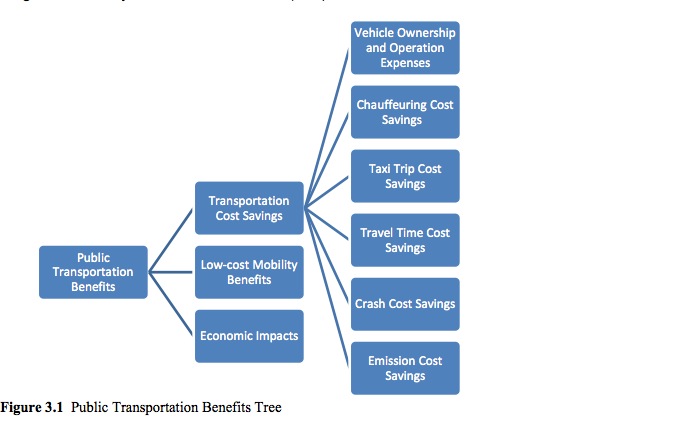NATIONAL CENTER FOR TRANSIT RESEARCH
1. Introduction
Transit systems in rural and small urban areas are often viewed as valuable community assets due to the
increased mobility they provide to those without other means of travel. The value of those services,
however, has been largely unmeasured, and there are often impacts that go unidentified. As transit
systems compete for funding at local, state, and federal levels, it is important to identify and quantify,
where possible, the impacts that the services have within local communities, as well throughout the state
or country. Critics may argue there are other, more productive, uses for transit funds or that the service
does not serve enough people to be worth the cost. Transit may be seen largely as a cost to be incurred
without much understanding of the benefits. The benefits accruing to transit services, especially those in
rural areas, have rarely been quantified, often because of a lack of data or the costs of collecting those
data.
Benefits to the transit user include lower-cost trips, new trips that are made, and relocation avoidance.
The alternative means of travel for transit users, which may involve purchasing an automobile or paying
for a taxi ride, are often more expensive. As transit provides access to work, health care, education,
shopping, etc., additional trips will be made for these purposes, resulting in increased earnings, improved
health, involvement in social activities, and additional spending in the local community. Furthermore, the
service reduces the likelihood of transportation-disadvantaged individuals experiencing isolation and
depression.
Without transit service, some individuals may need to move to larger communities, which could be costly
at the individual level but would also have economic consequences for small communities. By increasing
the number of trips made and making it possible for individuals without other means of travel to continue
living in their community, transit service has the impact of increasing spending in the community and
inducing additional economic activity. Transit service can also provide energy and environmental
benefits, through reduced fuel consumption and emissions, and benefits through improved safety and
security, which may be especially important for older adults with reduced driving abilities. Finally, the
existence of transit operations also creates economic activity in the community. This includes jobs created
directly by the transit system, income generated by industries that supply inputs to the transit system, and
induced economic activity.
Decision makers need objective and credible information on both the costs and benefits of transit
operations to support their decisions regarding investment in public transportation. Some of these benefits
lend themselves easily to quantification, while others do not. A full representation of the benefits,
including both quantitative and qualitative benefits, is necessary for local and state governments to make
informed choices.
A number of challenges exist when conducting this type of analysis. The study needs to be careful to
avoid double counting because there are many interrelated benefits. It should include sensitivity and
contingency analyses. Attempts should be made to quantify as many benefits as possible, but combining
benefits into a single measure could be misleading if the data do not lend themselves to such a procedure.
Information should be presented in a manner that facilitates decision making.
The objectives of this study are as follows:
1) Provide a comprehensive review of previous cost-benefit research for rural and small urban
transit.
2) Develop a detailed methodology for assessing economic benefits of rural transit at the
national, regional, and statewide levels.
3) Estimate the economic costs and benefits of rural and small urban transit.
4) Identify and describe social, environmental, and other intangible benefits of rural and small
urban transit.
The report is organized as follows. Section 2 discusses previous cost-benefit research that has been
conducted, focusing on research in rural and small urban areas. Section 3 describes the categorization of
transit benefits for this study. Section 4 documents the framework adapted in this study for monetizing
transit benefits and conducting the benefit-cost analysis. A summary of the data sources and descriptions
of procedures followed for analyzing each category of transit benefits are also presented. A summary of
cost data for rural and small urban agencies across the country is provided in Section 5. These data were
obtained from the National Transit Database (NTD). In Section 6, results from the quantification of transit
benefits, including transportation cost savings and low-cost mobility benefits, are presented. Section 7
describes the methodology used to determine the economic impact benefits created by transit, and the
strategy presented in this section is applied to the state of North Dakota to summarize the economic
impact benefits for the state. Section 8 presents the benefit-cost analysis of small urban and rural transit
nationally, regionally, and statewide. The results of sensitivity analysis for various scenarios are provided
in Section 9, showing the degree to which the results are sensitive to different variables. Finally, a
summary and conclusions are presented in Section 10.
Download full version (PDF): Cost-Benefit Analysis of Rural and Small Urban Transit
About the National Center for Transit Research
www.nctr.usf.edu
The National Center for Transit Research (NCTR) is located at the Center for Urban Transportation Research (CUTR) at the University of South Florida (USF). NCTR’s purpose is to make public transportation and alternative forms of transportation, including managed lanes, safe, effective, efficient, desirable, and secure.







 RSS Feed
RSS Feed